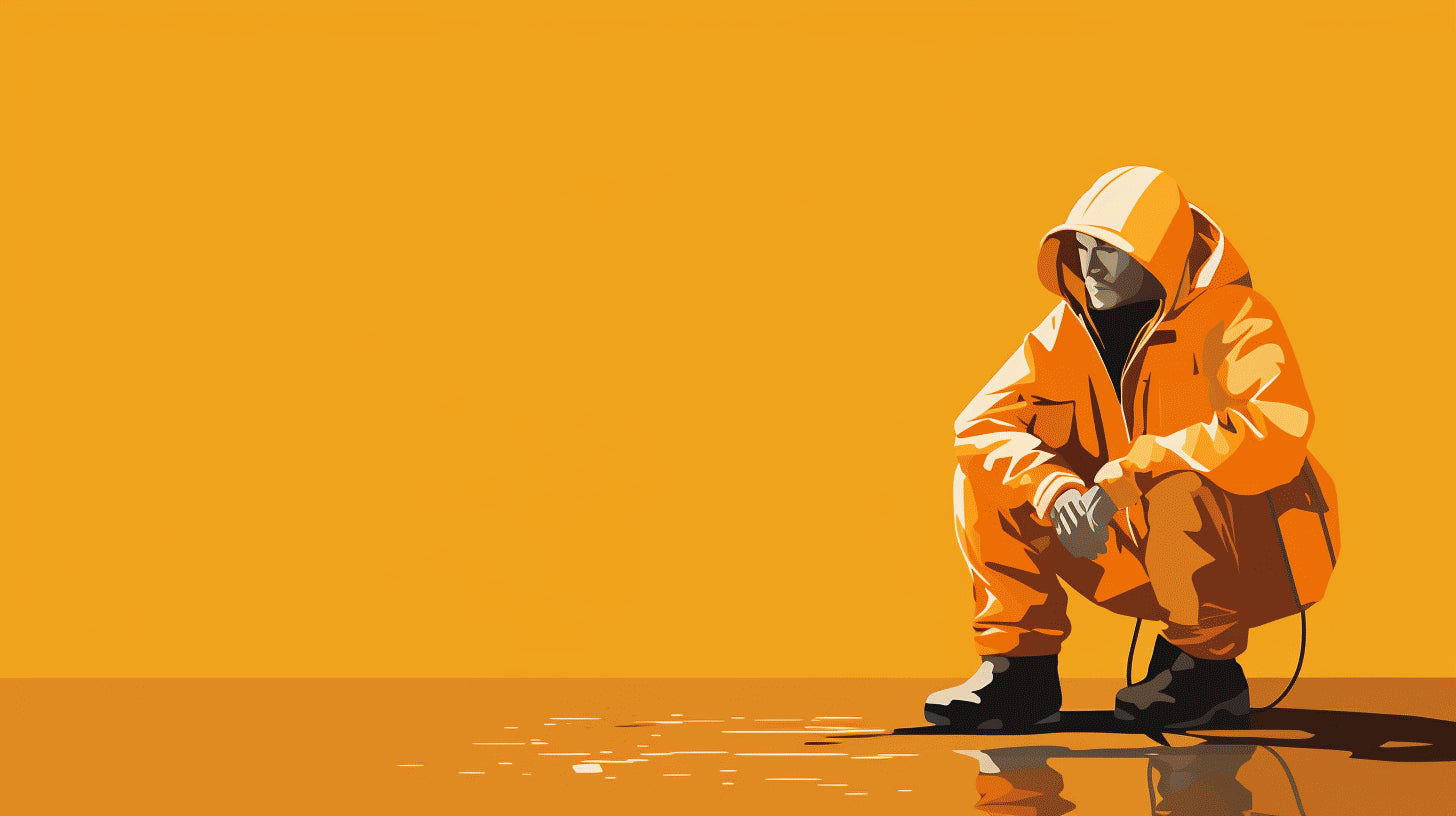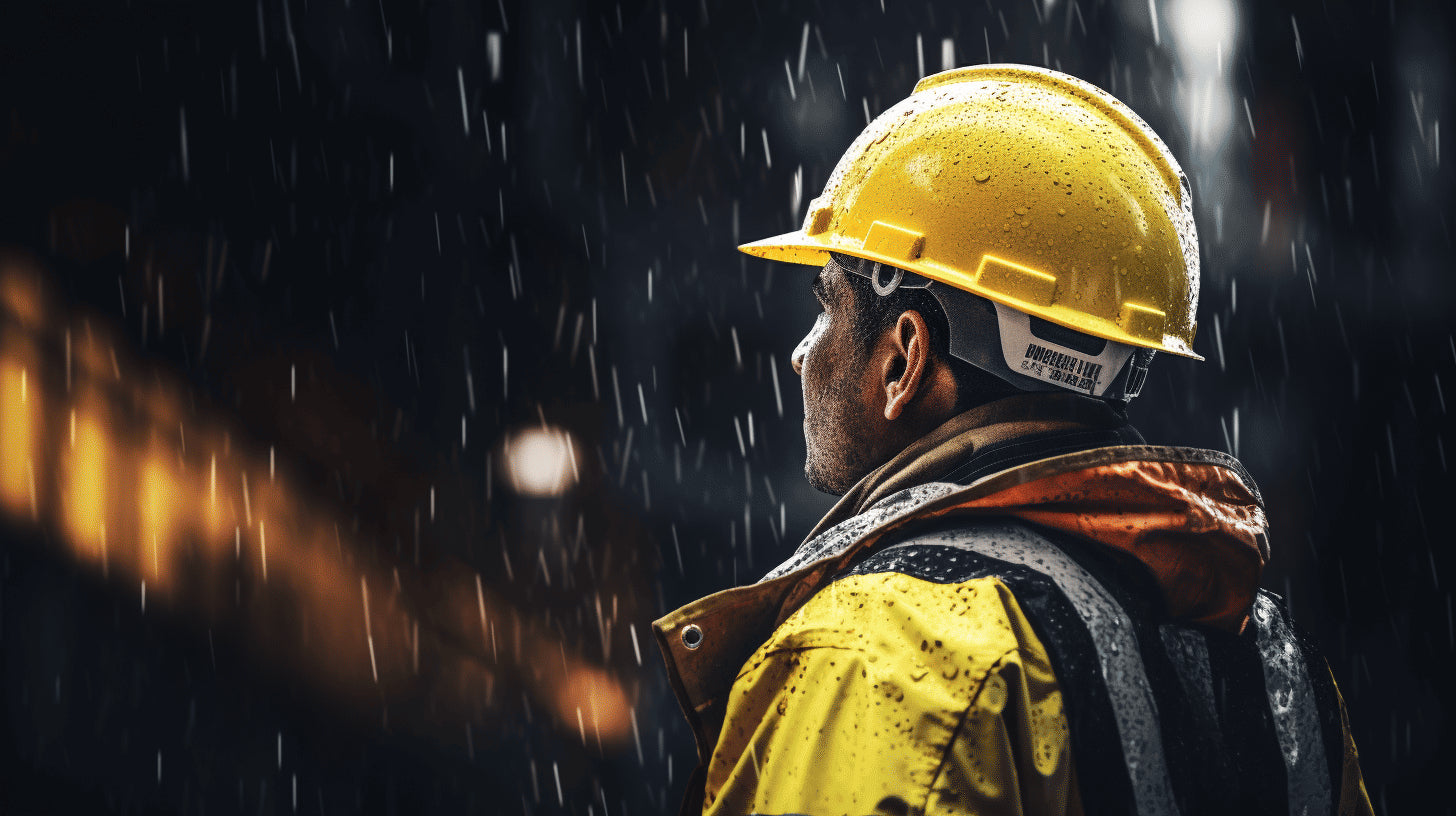As the wipers fight against an unrelenting downpour, your sight is set on the construction site on your horizon. Workers, though doused in precipitation, stride through the project area. Amidst the rigorous hustle and inclement weather, one thing remains evident - these individuals are the backbone of a growing infrastructure, their safety paramount.
But how does one increase the safety quotient on a construction site? The answer lies in the most elemental and overlooked aspect of protection - durable rain gear. This section takes a close gander at how sturdy and well-designed rain gear not only shields construction workers from harsh weather conditions but also substantially augments site safety. Come rain or shine, the key to enhanced security stands stitched in the fabric of rain gear.
Importance of Safety at Construction Sites
When diving into the rich world of construction, safety at job sites is a paramount concern. Every construction professional needs to adhere to safety standards in order to enhance productivity, lower insurance premiums, and most importantly, to keep everyone on the job site unharmed. However, there are still many compelling reasons why safety is often underrated on many sites, with wet weather conditions being a pressing issue.
Dangers of Wet Conditions
Wet conditions can drastically increase the danger at construction sites. A sudden downpour can not only halt work activities but also create slick, muddy surfaces that can lead to slips and falls. In addition, wet weather can cause havoc on equipment, make it difficult for workers to see and hear one another, and can even lead to electrical incidents if water comes into contact with power lines or machinery.
- Wet surfaces can cause slips and falls
- Vision and hearing can be impaired
- Equipment can be damaged, causing operational delays
- Electrical incidents may occur if water contacts energized elements
Prudent managers know that understanding and mitigating these potential hazards is essential, but there's so much more to the larger picture.
Contributions to Accidents
Ignoring safety rules, unclear instructions, and poor safety culture are often major contributors to accidents on construction sites. Under wet conditions, the risk of accidents further elevates, resulting in potential injuries or even fatalities. There's nothing more demoralizing to a team than seeing a fellow worker injured due to negligence.
- Lack of clear safety instructions can lead to confusion
- Poor safety culture can increase accident risks
- Negligence can cause injuries or fatalities
These factors blend into a dangerous concoction that significantly impacts not just the workers' safety, but also the overall productivity of the construction project.
Impact on Productivity
Safety issues at construction sites directly impact productivity levels. After an accident, work often stops for investigations, potentially resulting in project delays. A high accident rate can also increase employee turnover and make it difficult to recruit experienced workers. Thus, adhering to safety measures is not only a way to ensure employees' well-being; it's also a smart business practice.
- Work stoppages can lead to project delays
- High accident rates may increase employee turnover
- Safety adherence is a sound business practice
It's clear that a robust safety culture benefits everyone involved. Whether it's reducing accident rates, enhancing productivity, or simply maintaining morale, ensuring safety at construction sites should be the top priority for every construction professional.
Role of Rain Gear in Enhancing Safety
In our everyday life, we often have to face the unavoidable wrath of Mother Nature. Unexpected showers can leave us drenched and uncomfortable, but more importantly, it can also lead to safety concerns. This is where the power of rain gear steps in. Specialized rain gear doesn't just protect us from the wet and cold, but it plays a pivotal role in enhancing our safety in many significant ways.
Protection From Harsh Weather
The most rudimentary function of rain gear is to shield us from harsh weather. Trench coats, rain pants, rubber boots, waterproof gloves, and umbrellas—they have all been designed ingeniously to prevent us from getting wet. But the benefits run deeper.
- Keeps You Dry: Rain gear keeps you dry and thereby lowers the risk of catching cold-related illnesses. In specific scenarios, hypothermia can also be prevented.
- Preserves Body Heat: The waterproof layer in the rain gear effectively encapsulates body heat, preserving the body's optimal temperature.
Avoiding Slip and Slide Accidents
Have you ever slipped on a wet, rained-upon surface? If so, you'd know how risky it can be!
- No More Slips: Most rain boots come with soles made of heavy-duty rubber, providing excellent grip on slippery surfaces.
- Cushion Against Falls: Some rain gear, like jackets and pants, might have padded sections that can cushion the impact if you happen to fall.
Increasing Visibility in Poor Weather Conditions
Poor visibility due to rain can lead to accidents, especially for cyclists, motorcyclists, and pedestrians. Wearing rain gear in bright colors can significantly increase your visibility to others.
- Stay Visible: Vibrantly colored rain gear or ones with reflective panels can make you more visible to drivers, thus averting possible mishaps.
- Clear Vision: Rain gear also includes accessories like waterproof hats and hoods, which prevent the rain from blurring your sight, thus enabling you to navigate safely.
Undeniably, rain gear plays an essential role in enhancing safety during unfavorable weather conditions. Its careful design works to shield you from the weather, prevent untimely falls, and increase your visibility to others, contributing to an overall boost in personal safety. So, before shrugging off that bright, bulky raincoat as an inconvenient wardrobe piece, remember the significant layer of protection and safety it offers.
Selecting the Right Rain Gear for Construction Work
As a construction worker, staying safe and dry in the rain entails more than just grabbing the nearest umbrella. It involves selecting the right rain gear that can withstand the rigors of the job while keeping you comfortable in challenging weather conditions. When it comes to choosing the best rainwear for construction work, three main criteria play a monumental role: material durability, water resistance, and visibility features.
Material Durability
Arguably, the most crucial factor to consider in construction rain gear is the material's durability. A typical construction site can be a tough environment, and your gear needs to resist physical damage, wear and tear, and the stresses inflicted by heavy machinery and tools.
- Cotton and Polyester: If comfort is a priority, go for gear made from a hybrid of cotton and polyester, providing an excellent balance between durability and comfort.
- Nylon and PVC: Beyond comfort, nylon and PVC offer remarkable tear and abrasion resistance, making them a worthy consideration for heavy-duty construction environments.
Choosing the right material translates not only to physical comfort but also to the longevity of your gear, lessening the need for frequent replacements.
Water Resistance
Regardless of the construction site's nature, rainwear efficacy is primarily gauged by the degree of its water resistance. While several materials promise waterproof properties, always verify these claims.
- Coated fabrics: Consider rainwear made from coated fabrics, such as PVC, urethane, or rubber. This type of gear offers a great deal of water resistance with a sturdy layer that prevents water seepage.
- Waterproof membranes: Alternatively, opt for rainwear with waterproof membranes that repel heavier rain, preventing moisture buildup.
Ensure the gear is not only waterproof but also breathable, allowing sweat to evaporate, preventing you from getting uncomfortably damp or overheated.
Visibility Features
Finally, safety should be the utmost priority of any construction work, which includes staying visible under heavy rain or fog. Some rain gear possesses high-visibility features – vibrant colors or reflective strips – that can significantly enhance your visibility in poor weather.
Choose rain gear with reflective accents and bright colors such as neon yellow or orange. These can make a significant difference in your safety and those around you, ensuring you're visible even from a distance.
When you approach the task of selecting the right rain gear for construction work, keep in mind the importance of a balance between durability, water resistance, and visibility. In doing so, you'll not only weather the storm but do so comfortably, securely, and efficiently.
Additional Safety Measures to Complement Rain Gear
Throughout the year, we can't escape the inevitability of rainfall. Whether you are on a camping trip or on your way to work, rain can color your daily routine. Waterproof clothing and rain gear protect you from the adverse effects of rain, but they are not the only things you should consider. For complete protection, you also need to focus on proper equipment maintenance, weather-appropriate training, and regular safety checks.
Proper Equipment Maintenance
Maintaining your gear is the most effective way to ensure your safety when dealing with the rain.
- Inspect your rain gear regularly: Prolonged use results in wear and tear. Even the smallest damage can lead to potential leakages. Do not forget to check your raincoat's seams or your umbrella's skeletal structure.
- Clean your gear properly: After exposure to rain, dirt and debris accumulate in your gear. Make sure to remove any traces to avoid spoilage and to retain the gear's waterproof coating.
- Store your gear correctly: Incorrect storage can wreak havoc on your rain gear. Keep them in a dry and cool area to prevent the growth of mold and other factors that can affect the gear's longevity.
Weather-Appropriate Training
Knowledge is your best friend when it comes to managing unexpected weather conditions.
- Understand how rain affects your surroundings: Wet roads and paths are slippery, making them dangerous. Knowing how to navigate such situations keeps you safe.
- Learn how to use your gear correctly: Gear is effective only when used correctly. Know how to adjust, fasten, and secure your gear to get its full benefits.
- Prepare for other weather conditions: Rain often goes with wind and lower temperatures. Learn to manage these accompanying weather conditions.
Regular Safety Checks
Safety checks are equally important as owning prime rain gear.
- Check your gear before heading out: Don't assume your gear is in top shape. Always do a quick check before leaving the house.
- Test new rain gear: Newly purchased rain gear can have manufacturing defects. Make sure to test them under controlled conditions before relying on them completely.
- Pay attention to weather forecasts: Regularly check the weather update. It gives you time to prepare and make necessary adjustments.
While rain gear provides an outer shield, integrating these additional safety measures into your habits ensures maximum protection. When combined with reliable rain gear, they form a solid defense against the rain. Harness the power of these measures, stay dry, and better enjoy the rainy days.
Impact of Durable Rain Gear on Construction Site Safety
The construction industry often grapples with challenging working environments, and adverse weather conditions, particularly heavy rainfall, are common disruptors. But have you ever considered the impact that durable rain gear can have on construction site safety? Not only can rain gear keep workers dry during gloomy weather, but it can also significantly enhance safety when selected with due diligence.
Safety is an undeniable priority at construction sites. Thus, one cannot disregard the role of suitable rain gear with reinforced durability.
Let's look at some ways rain gear can boost safety measures on a rainy construction site:
- Slip-resistance: A damp construction site can result in slippery conditions, increasing the peril of accidental slips and falls. Durable rain boots, incorporated with slip-resistant technology, become an indispensable safety feature.
- Visibility: In heavy rains, visibility can plummet. High-visibility rain gear, packed with reflective accents, keeps workers visible, hence reducing the risk of accidents.
- Comfort & Mobility: Durable rain gear is designed to offer comfort without compromising mobility. This is vital in preventing workers from getting distracted and making inadvertent mistakes that may lead to accidents.
Let's underline the statement by Walt Stickney, a renowned site safety specialist, as he once said:
"Do not overlook the importance of safety wear, especially in adverse weather conditions. How well the gear can withstand the elements plays a significant role in ensuring overall site safety."
Undeniably, durable rain gear is a critical asset in the construction industry, offering a range of benefits. By choosing the right rain gear, construction companies can ensure safety norms are met, even when weather conditions are unfavorable. It's all about the harmony of comfort, functionality, and durability of the gear in promoting safety at the construction site amid the rain.
So, remember, next time there's a forecast of rain, rather than seeing it as a potential disruptor, perceive it as a chance to reinforce site safety measures with reliable, durable rain gear.
Conclusion
In a demanding industry such as construction, embracing safety measures like reliable rain gear is not just a necessity, but a significant responsibility. Ensuring protection against harsh weather and hazards not only promotes physical safety but also leads to more effective operations.
The comprehensive range of products offered by Hurricane Raingear has been trusted by thousands for their exceptional functionality and durability. Helping construction professionals remain seen, safe, and skilled at their trade even in demanding weather conditions, it exemplifies our commitment to safety and well-being in the workplace.
Hence, integrating rain gear into your safety protocols can indeed make a meaningful difference in promoting overall site safety and productivity.
Frequently Asked Questions
-
What are the key benefits of using durable rain gear at construction sites?
Using durable rain gear at construction sites offers several benefits such as protection from rain, increased visibility, prevention of slips and falls, and preservation of workers' health and comfort.
-
What features should I look for in durable rain gear for construction sites?
When choosing durable rain gear for construction sites, look for features like waterproof and breathable materials, reflective accents, adjustable cuffs and hems, reinforced seams, and multiple pockets for carrying tools and equipment.
-
Are there specific safety standards for rain gear used at construction sites?
Yes, rain gear used at construction sites should comply with safety standards such as ANSI/ISEA 107 for high-visibility apparel and ASTM F2407 for rainwear. Ensuring compliance with these standards guarantees better safety and protection for workers.
-
How often should I replace my rain gear at construction sites?
The lifespan of rain gear depends on factors like frequency of use, maintenance, and the quality of the product. However, it is generally recommended to replace rain gear at construction sites every 1-2 years or whenever there are signs of damage or wear.
-
Can I use regular rain gear instead of specialized construction rain gear?
While regular rain gear may offer some protection, specialized construction rain gear is designed to meet the unique safety requirements of construction sites. It provides additional features like high-visibility colors, reflective accents, and reinforced durability, making it a more suitable choice for construction workers.























Leave a comment
This site is protected by hCaptcha and the hCaptcha Privacy Policy and Terms of Service apply.